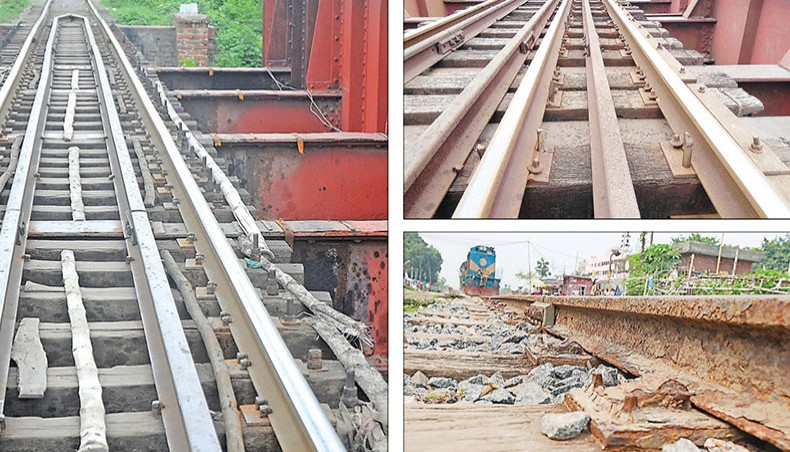Wood, bamboo used at railway tracks, bridges!
The Bangladesh Railway is using wood and bamboo instead of iron equipment at rickety railway tracks and bridges in at least two major sections, posing great risks of fatal accidents.
Wooden and bamboo sticks are in use at some railway bridges in the Bangabandhu Bridge (East)-Joydebpur section while bamboo slices are being used to keep rail tracks in place at Dayaganj in the Dhaka-Narayanganj section.
Dilapidated railway tracks are not uncommon even within the capital.
Over the recent years while rehabilitation of old and rundown tracks and bridges have become a major concern for train passengers, use of wood and bamboo at tracks was seen in different sections of the railway from time to time.
The two committees formed to probe the June 23 fatal train accident in Moulvibazar that killed four people also found poor maintenance and monitoring of tracks responsible for the accident.
The next day prime minister Sheikh Hasina at the weekly cabinet meeting directed the authorities concerned to replace the old and risky railway bridges in phases to avert such accidents.
Bangladesh Railway’s newly appointed director general Md Shamsuzzaman told New Age on Thursday that bamboo slices that were used on the sides of main tracks was not a threat to train movement but the use of wooden or bamboo sticks instead of dog spikes was risky.
‘I believe some people mistakenly used … wooden and bamboo sticks in Tangail as part of maintenance,’ he said, adding, ‘We regularly check our tracks but I don’t know how it happens after that.’
The use of wood and bamboo at rail tracks is a proof of mismanagement in the Railway and negligence in duties by its staff, said engineering and safety experts.
Railway has a total of 4,324.75 kilometres of rail tracks across the country, of which most were built during the British period and many of these need an overall rehabilitation, officials said.
More than 900 of the 3,143 railway bridges are in disrepair, said Railway officials.
At present, railway’s Akhaura-Sylhet (176 km), Bhairab Bazar-Gouripur (100 km) and Tista-Ramnabazar (47.56 km) sections need total rehabilitation as these have become dilapidated, said railway’s engineering department officials.
In the Akhaura-Sylhet section, four compartments of the Upaban Express went off the tracks on June 23 at around 11:45pm when the train was approaching Barochhara Bridge near Boromchal railway station under Kulaura upazila in Moulvibazar and a coach fell into the canal beneath the bridge, leaving four passengers dead and 100 more injured.
The New Age correspondent in Tangail reported that pieces of wood and bamboo were being used in many railway bridges from the Bangabandhu Bridge (East) in Tangail to Joydebpur risking the lives of train passengers.
On Thursday, it was found that pieces of wood and bamboo were in use instead of iron dog spikes (a dog spike is a large nail used to secure and fasten rails in a railway system) on the Jokarchar, Hoteya and Char Bhabla railway bridges in Kalihati upazila.
On the Jokarchar bridge, dog spikes were not seen at rail tracks at many places and instead wooden and bamboo sticks were used to hold the tracks together.
As wooden sleepers on bridges at many places have become rickety the dog spikes were found missing and on some spots the iron tracks were kept aside the line.
Locals have alleged that drug addicts regularly steal parts of the tracks and iron nails.
According to Joydebpur railway station officials, a total of 132 railway bridges in the Bangabandhu Bridge (East)-Joydebpur section were built in 1998, which were not repaired since then.
New Age published a photo on June 30 this year, which showed that bamboo slices were used on the sides of the main line on a culvert to support them at Dayaganj in the Dhaka-Narayanganj section.
Iron nails were recently found to be broken on rail tracks at Tejgaon railway station in the capital.
In January 2017, New Age also found bamboo slices placed on the rail tracks at Jothgobordhan near Tograihat railway station and over a box culvert at Trimohoni on the Teesta Bridge-Ramna Bazar (Chilmari) branch line in Kurigram.
At around the same time, bamboo was also found to be used at rail tracks on a bridge in Moulvibazar to support the main lines.
Former director of the Accident Research Institute at the Bangladesh University of Engineering and Technology Professor Md Shamsul Hoque told New Age that replacing dog spikes with wooden and bamboo sticks was not acceptable from engineering perspective.
‘They [wooden and bamboo sticks] risk accidents,’ he said.
After the Moulvibazar accident the Railway asked its staff to run trains slowly and that step reduced the operating cost, he said.
‘The maintenance cost [of the railway lines] is low compared to big projects undertaken by the Railway,’ he said, adding, ‘This compromise is not acceptable at all.’
He also alleged that the Railway staffs were not carrying out their duties properly, too.
Project officer Md Atiqur Rahman of Work for a Better Bangladesh Trust, an NGO, has said that new compartments or locomotives would be of no use if the rail tracks are not alright.
‘Use of wood and bamboo [at rail tracks] exemplifies total mismanagement and negligence in duties of Railway people,’ he said.
Atiqur said that the Railway should use its staff properly for the right kind of maintenance of the rail tracks, ‘Otherwise, people will start avoiding trains fearing possibilities of accidents.’
Railway DG Md Shamsuzzaman said that they used bamboo slices on the sides of main tracks to keep them in place but recently they took a decision to use iron plates on those spots.
They also decided to start the trolley system in the Akhaura-Sylhet section to check old tracks in order to keep the train movement smooth, he added.
He also said that they had taken initiatives to repair the risky bridges as per the recent directive of the prime minister.
News Courtesy: www.newagebd.net











